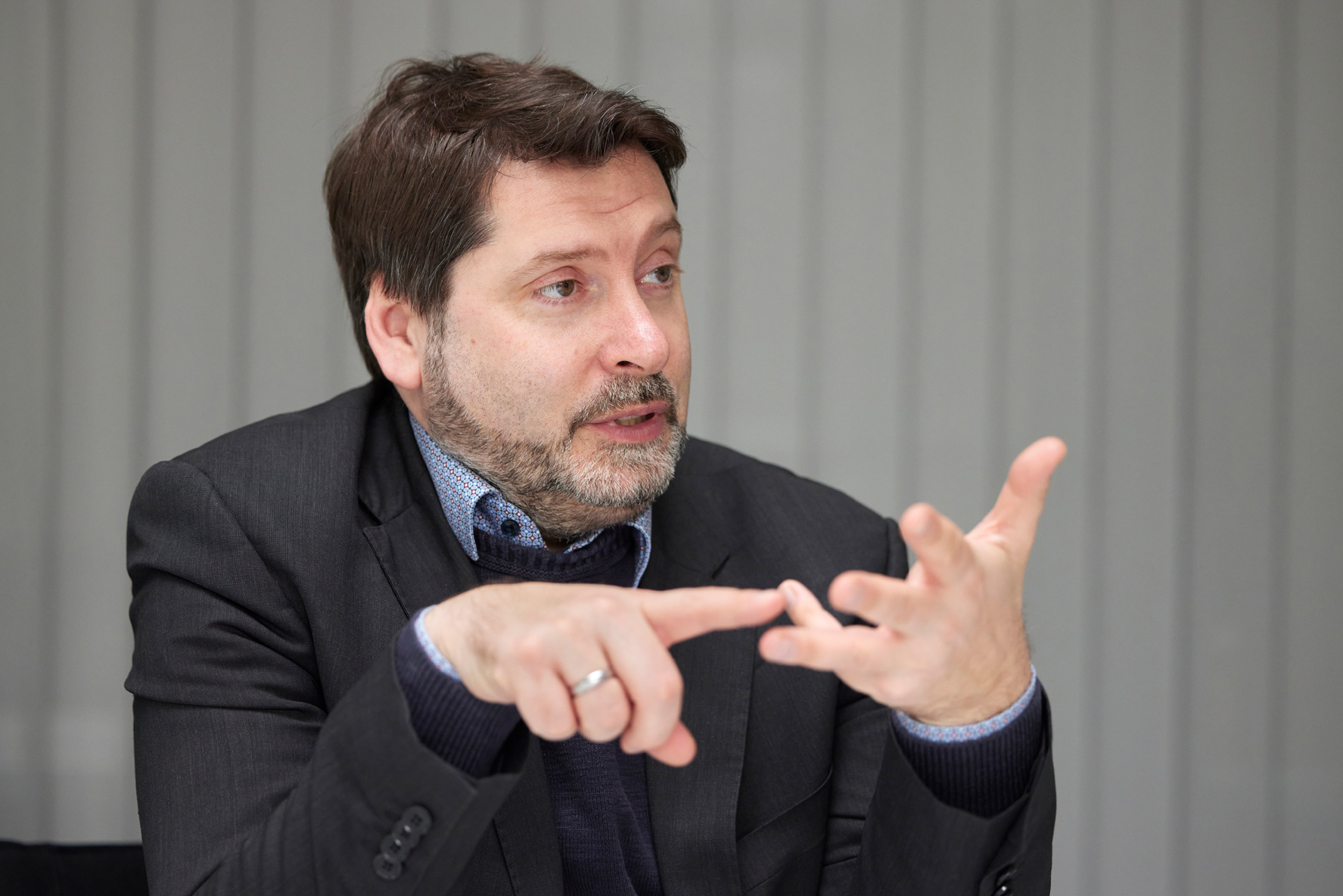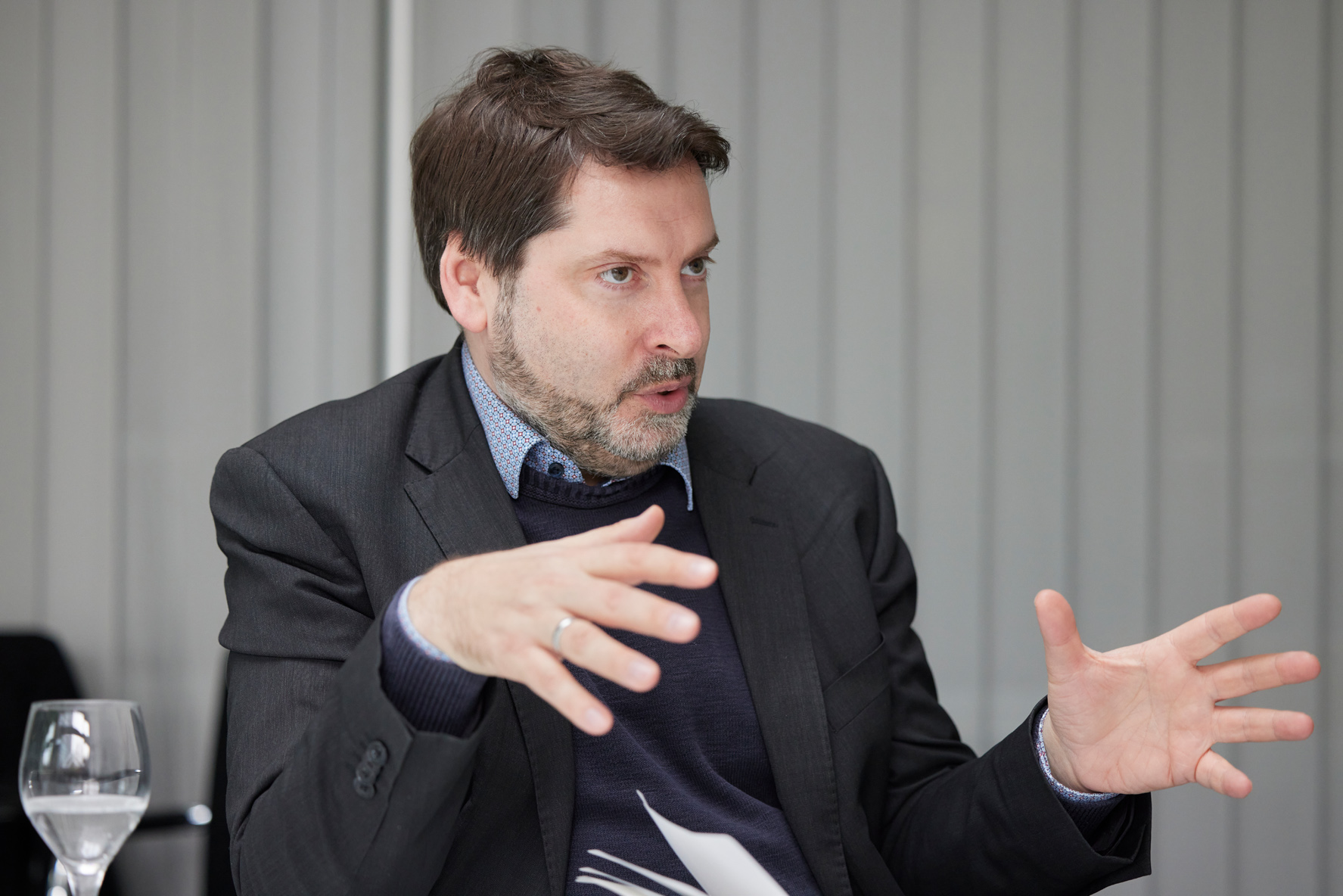After the Second World War, Japan needed technology to rebuild. Motivated by industrial policy measures, the first companies settled in Duesseldorf in the 1950s. Today, the Japanese community in Duesseldorf numbers around 8,500 and has shaped the city, not only economically but also culturally. In his dissertation, Dr Konstantin Plett examined how the Japanese community in Duesseldorf came to be and how it has developed over its 70-year history. J-BIG spoke to him about how he went about his research, what factors made Duesseldorf attractive as a business location, and how the city and the Japanese community interacted.
J-BIG: Your dissertation “The History of Duesseldorf as a Japanese Business Location” will be published soon. Why did you choose this topic for your thesis?
Konstantin Plett: I studied Japanese during my bachelor’s and master’s degrees, and during that time I delved deeply into Japanese society and social problems in Japan. I was also born in Duesseldorf and had long been interested in the Japanese community here. The question of why so many Japanese have come to Duesseldorf has not yet been answered conclusively at the research level. This is also why the Gerda Henkel Foundation offered a scholarship in connection with this research field. The topic emerged from the interplay of these various factors.

J-BIG: How did you approach the subject?
Konstantin Plett: My research method rested on two pillars: Archival research and eyewitness interviews. For the former, I used numerous archives, including the Duesseldorf city archive and the archives of Japanese institutions and companies. I started in Duesseldorf and then flew to Japan to see what research had already been done on the Japanese side in the archives. My language skills from my Japanese studies gave me access to Japanese-language sources. It was important for me to look at the matter from both sides.
J-BIG: Where exactly did you look for information in Germany and Japan?
Konstantin Plett: Many Japanese companies were originally based in Hamburg. Therefore, most of the documents on the history of the Japanese community are to be found in Hamburg and not, as one might assume, in Duesseldorf. The Duesseldorf city archives contain information about the city as a business location with links to Japan dating back to the 1960s. However, the relocation to Duesseldorf actually began in the 1950s. In order to obtain information about the first settlement of Japanese companies in Hamburg and their later move to Duesseldorf in the 1950s, I had to use company archives in Germany and Japan as well as chronicles of Japanese companies. A large part of the archival research also consisted of scouring newspapers for Japan-related topics. The period of research I covered stretched from the 1950s to the turn of the millennium, a few years after the collapse of the economic bubble in Japan.
For the eyewitness interviews, I spoke to around 30 people involved in the location’s history, including expatriates from Japanese companies who set up a branch in Duesseldorf in the 1970s or 1980s, as well as local initiators who maintained early contacts with Japan in the context of economic development. Interviews were conducted in German and Japanese. In the end, 25 of the interviews were included in the thesis. Together with archival research, this enabled me to reconstruct the history of the Japanese community and Duesseldorf as a business location.
J-BIG: How long did this research phase last?
Konstantin Plett: The project officially started in December 2018, and thanks to funding from the Gerda Henkel Foundation, I have been able to focus on it full-time since then. The first year and a half was pure research, and in the summer of 2020, I also started writing. The research phase was really completed at the end of 2021. The evaluation of the materials in particular took a long time.

J-BIG: You mentioned a migration from Hamburg to Duesseldorf. Why did the Japanese companies come to Hamburg in the first place, and what made them move to Duesseldorf?
Konstantin Plett: After the Second World War, Japan was destroyed and needed technology to rebuild. The industrial policy of the Ministry of International Trade and Industry (MITI), now METI (Ministry of Economy, Trade and Industry), established a planned economy: Companies were given capital and tax breaks to acquire technology abroad. At the time, Japan was an exporter of light industry, textiles, and consumer goods. The steel industry, on the other hand, was not as developed after the war as it was in Germany, for example. But steel was needed to modernise other industries. The government therefore prioritised this industry, and companies that developed in this area were given special support. Companies that had been destroyed by the occupying powers had little capital and were dependent on state subsidies.
Duesseldorf was home to large coal and steel companies. Even before the 20th century, the region around Duesseldorf was the steel centre of Germany. In the early 1950s, Japanese companies with a strong iron and steel business were the main arrivals. Textile companies initially settled in Hamburg, where many German trading houses dealing in light industrial products were based. The port facilitated the import and export of consumer goods.
Later, as industrial structures changed in the 1950s and 1960s and heavy industry became more important than light industry, Duesseldorf began to attract more and more companies. Many moved their headquarters to Duesseldorf. So the nucleus of Duesseldorf as a business location was the German steel industry, combined with the economic situation in Japan after the war.

J-BIG: Did the Japanese companies already have the intention of tapping Germany as a sales market at that time?
Konstantin Plett: The aim of the Japanese companies was to acquire patents for technologies, especially in the steel industry. For example, patents were acquired for the production of rolling mill presses or iron processing machines. At that time, Japan was not a global player in the steel industry, unlike Germany or America, so German companies sold their know-how and patents to Japanese companies at relatively low prices. So technology acquisition came first. The sale of Japanese products on the German market only followed later.
J-BIG: Is it possible to ascertain today which was the first trading house to settle in Duesseldorf?
Konstantin Plett: According to my research, it was Tokyo Boeki, Fujishoji and Okura. Tokyo Boeki was the first company to hold initial talks with German steel producers in Duesseldorf in 1950. Just one year after MITI was formed in 1949, the company came to Germany to establish contacts. The first Mitsubishi and Mitsui branches were established in 1954. Okura was a general trading company that opened its first representative office, a one-man operation, in Duesseldorf in 1952, before setting up a branch.

J-BIG: Were there any basic characteristics that distinguished Japanese companies from German ones at that time?
Konstantin Plett: After the end of the Second World War, there was a general restructuring in Japan, as the American occupying forces had broken up the corporate conglomerates. They were replaced by keiretsu, economic groups of Japanese companies, as a mechanism to reduce transaction costs. Because of Japanese companies’ dependence on foreign capital, general trading houses and companies organised themselves around their house banks. Companies that borrowed from the same bank formed a group. That is, all companies whose main source of capital was Mitsubishi Bank belonged to the Mitsubishi keiretsu. These structures played an important role; companies in the same group maintained close business relations and were intertwined in terms of capital ownership.

Japanese companies largely brought this industrial structure with them to Germany. The general trading houses played an important role within the keiretsu because the manufacturers depended on them to take their goods abroad. When the general trading houses settled in Duesseldorf, the product manufacturers in their group expanded there as well.
You could call it a poly effect: When many companies from a group move to a location, others follow – even from different sectors – and the location grows and grows. In the 1970s, the banks finally joined in. The companies in Duesseldorf were almost a mirror image of the corporate structures in Japan. At that time there were six major keiretsu in Japan: Mitsubishi, Mitsui, Fuyou, Daiichi Kangyo, Sanwa and Sumitomo. All of them had a local branch of their general trading houses and banks.
J-BIG: Put in numbers: How has the location developed?
Konstantin Plett: The first census after Japanese companies settled in Duesseldorf took place in 1961. The total number of Japanese in Duesseldorf was 279. In 1963, there were twelve Japanese general trading companies in Duesseldorf – compared to fourteen in the whole of Germany. By this time, the resettlement from Hamburg had largely been completed. Due to the strong integration of Japanese companies within the keiretsu, more and more companies settled in Duesseldorf; their number – and that of the Japanese population in the city – grew steadily. By 1965, there were already 800 Japanese living in Duesseldorf. This community created its own infrastructure, such as a Japanese school for their children, which in turn facilitated a further influx. As a result, the population grew by leaps and bounds. In 1970, the Japanese population in Duesseldorf and Hamburg was the same; five years later, the Japanese population in Duesseldorf was significantly higher. By the mid-1980s, there were about 4,000 Japanese living here, compared to only 2,000 in Hamburg.

J-BIG: How was the infrastructure expanded?
Konstantin Plett: An important factor in the development of the location were institutions such as the JIHK (Japanese Chamber of Commerce and Industry) and the Japanese Club, which were founded in Duesseldorf in the mid-1960s. The Japanese Club had already organised the first meetings of the Japanese community in the 1950s but was not officially registered as an association until 1964. It functioned both as a physical and material institution: there was a Japanese canteen, for example, and material goods were imported from Japan. The Japanese Chamber of Commerce and Industry, founded in 1966, represented the interests of Japanese companies and helped to make the location even more attractive. At the time, Japanese companies were taxed in both Japan and Germany, which discouraged many companies from registering and doing business in Germany. The JIHK lobbied for an agreement between Japan and Germany.
The classic expatriates were young workers with a few years of work experience, so many young families came to Duesseldorf. These families usually stayed abroad for three to five years before returning to Japan. The return of schoolchildren from abroad was seen as a social problem by Japanese society, as the children had lost their connection by attending school abroad. The impetus for establishing a Japanese school therefore came from the expatriate community in Duesseldorf. The desire for a full-time Japanese school was realised in 1971. The Japanese School Duesseldorf was the first of its kind in Europe, and no such institution existed in the USA. Many families chose to live in Duesseldorf because they could send their children to a Japanese school. Companies also increasingly set up shop here as expatriates became more willing to move abroad.
J-BIG: Today, Immermannstrasse, also known as “Little Tokyo”, is the centre of the Japanese community in Duesseldorf. Where did the companies settle originally?
Konstantin Plett: From the very beginning, the branches were located in the city centre. Not only in Immermannstrasse, but also in Königsallee, Berliner Allee and Schadowstrasse. In the beginning, however, these were not large branches; many representative offices had only a few employees. They wanted to be at the heart of the action, in the city centre. But as the companies grew, new needs arose that led to relocation. Today, you will mostly find Japanese restaurants and a few small Japanese businesses in Immermannstrasse. From the 1970s onwards, there was much more direct investment from Japan, which meant that larger branch offices could be built. They often looked for a location with many commercial sites: Ratingen, Willich and smaller locations around them. These business parks were more attractive, partly because of the lower business tax. The area is often referred to as ‘Greater Duesseldorf’, but a closer look at the distribution shows that the area extends beyond the city of Duesseldorf. On a micro level, there has certainly been a migration to the surrounding cities over the years as companies’ needs changed.


J-BIG: When did the German side notice and react to the growing Japanese community?
Konstantin Plett: The city’s interest in location promotion became apparent as early as the 1960s. Duesseldorf was looking for a unique selling point to promote the city’s internationality – and found it in the Japanese community. As early as the 1950s, attempts were made to market Duesseldorf as a business location to Indian companies. Then, in the mid-1960s, the city became aware of the development of Japanese infrastructure and sought to promote this as a unique selling point. This led to the idea of establishing a German-Japanese Centre to further promote the infrastructure. This proposal was realised with the Nikko Hotel, now the Clayton Hotel, on Immermannstrasse – a building complex that doubled as the German-Japanese Centre. The first idea for such an institution came from the City of Duesseldorf in 1963. Back then, it was called the Japan House. The original idea was to construct a building that would house all Japanese institutions and companies in order to create a clear centre and thus be able to market the location in Japan even better. However, this idea was met with much criticism, as there was still a lot of mistrust of Japanese companies in the 1960s. In the end, the centre was not completed until 1978, 15 years after the first draft. Initially, the building also housed the JIHK, the Japanese Consulate General and the Bank of Tokyo.
Another example of the City of Duesseldorf’s initiative is the ‘Japan Week’, the original idea for which came from the Economic Development Office. Theme weeks such as ‘British Week’ or ‘Swiss Week’ had been organised by the city of Duesseldorf as early as the 1950s to highlight the international aspect of the city. Its rival, Hamburg, held its own Japan Week in 1964. In Duesseldorf, the idea first came up in 1966, but for a long time, the city and the Japanese side could not agree on who should bear the costs. After many discussions, both sides came together and developed an understanding for each other. Finally, they agreed to share the costs and the first Japan Week was held in 1983, complete with a fireworks display. It was a great success. The name changed over the years, from Japan Week in 1993 to Japan Day in 2002, which has become an annual event.
The city also recognised the importance and economic potential of the Japanese School early on and waived the ground rent on the property. This enabled the school to improve its financial footing.

J-BIG: You mentioned that after the acquisition of patents, the export of Japanese products to Germany also began. When did this happen and what was sold at that time?
Konstantin Plett: In the 1960s, steel, iron and machinery were sold, including both small machines such as ball bearings and industrial machinery. In the 1970s and 1980s, exports increased again and expanded to include the electronics industry. While consumer electronics tended to be more concentrated in Hamburg, the focus in Duesseldorf was on B2B components such as semiconductors and automotive parts. As more and more was exported to Germany and less and less was imported back to Japan, Japanese companies were criticised and threatened with trade restrictions to limit their exports. The Japanese then thought, “OK, if we’re not allowed to export so much, we’ll invest in branches in Germany and sell our products directly from there”.
In 1984, the “Exhibition of German Industry” was held in Tokyo. The trade fair provided an opportunity for business leaders from German big industry in particular, but also for medium-sized companies, to show their presence in Japan. It was organised in cooperation with MITI and JETRO (Japan External Trade Organisation), and it was agreed that there was no point in regulating the market. Instead, the aim would be to create a dialogue between the companies. This gave rise to the Japanese-German Business Association (DJW) in Duesseldorf. JETRO itself initially focused on helping Japanese companies acquire technology. Later, market knowledge was needed to facilitate exports, and it gradually evolved into an organisation that helps Japanese companies bring products from abroad to Japan.
J-BIG: After the boom of the 1980s, the Japanese economy went into a severe recession when the stock market bubble burst in the early 1990s. Was this also felt in Duesseldorf?
Konstantin Plett: During the boom of the 1980s, the Japanese community in Duesseldorf grew significantly. This was also due to the Plaza Accord, which provided for a devaluation of the US dollar against the yen and the German mark through controlled influence on the international currency markets. As a result, the Japanese yen became more expensive and Japanese companies invested abroad even more. This led to more direct investment, and the business location grew significatly.
At the time, there were around 300 Japanese companies in Duesseldorf. Today, decades after the bubble burst, there are about 400. There was no slump, but growth stagnated as Japanese companies became less willing to invest. Fewer expatriates were sent, and more local staff were hired instead. As a result of the economic stagnation, some banks went bankrupt or had to merge. Japanese companies had to open up to the foreign capital market. These restructurings broke up the keiretsu structures. With their disappearance, an important pull factor for Duesseldorf was also lost.

J-BIG: When was the peak of the Japanese population in Duesseldorf?
Konstantin Plett: A first peak was reached in 1992 with around 6,000 Japanese residents. After that, the population declined and hovered around 4,000 for many years. It was not until 2014 that Duesseldorf passed the 6,000 mark again, and it has been growing ever since – today we are talking about around 8,500 Japanese in Duesseldorf. The Japanese population has also become much more diverse. In the past, infrastructure service providers and expatriates formed the core of the Japanese population. Today, many young Japanese are coming to work, and more and more of them are staying in Germany permanently and starting families here. The number of Japanese students and artists in Duesseldorf has also increased. In 1992, the Japanese school had 1,000 students. This number has not been reached since because the demand for Japanese education is no longer as great. Many Japanese children now attend German schools.

J-BIG: How was the prosperity of the bubble years reflected in the investments of Japanese companies in Germany?
Konstantin Plett: One example is the Kosaido golf course, which was built in the 1980s with Japanese investment. Golf still plays an important role in cultivating business relationships in Japan. In addition, the rather expensive hobby is an expression of wealth. For Japanese entrepreneurs, having their own Japanese golf course was a real highlight. Such investments are an expression of wealth during the bubble years.
J-BIG: How would you describe the development of the last thirty years after the end of the bubble economy?
Konstantin Plett: In the last thirty years, competition for Japanese companies has increased and some have moved to other cities. Since the turn of the millennium, Duesseldorf is no longer unique as a Japanese business location. For certain sectors, other locations such as Munich, Frankfurt and to some extent Berlin have become established. Frankfurt, for example, gained importance with the restructuring of Japanese banks after the crisis of the 1990s. Hamburg, on the other hand, only plays a minor role today.

Moreover, as fewer expatriates and more local staff were hired, companies paid less attention to Japanese infrastructure when choosing a location. They judged which location was the most attractive for the company purely from a business perspective. You could say that whereas in the past, soft location factors were more important, today it is the hard factors that matter most. For this reason, the location has stagnated considerably over the years, even though the absolute number of companies has hardly changed since the early 1990s. Duesseldorf’s unique infrastructure selling point is now much more evident at the cultural level. A distinct scene has developed around Immermannstrasse, and Duesseldorf has become very well known for East Asian cultures in general. Duesseldorf is also attractive to young Japanese who go abroad. This cultural level has also made it possible for new economic sectors to develop around the food and beverage industry or pop culture. So the development goes on and on – and Duesseldorf will continue to play an important role in German-Japanese relations.



